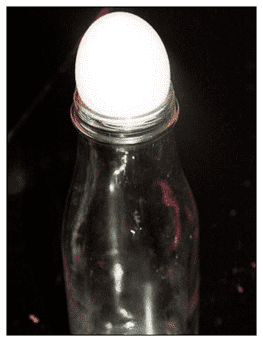
Eggs are generally something that you consume as a source of food but with the help of this project you will learn something new about science. This experiment will show that the use of oxygen molecules in a particular area causes a loss of air pressure.
Materials
- Medium sized boiled egg.
- Boil eggs by placing eggs in a pot with enough to cover completely by 1-2 inches above eggs. Bring them close to a boil. Once the water is boiling, turn the heat to medium and allow to cook for 10-minutes.
- Remove from heat and place under cool water to chill them quickly.
- Crack and peel.
- Bottle with a neck just small enough that the egg won’t fall in (Erlenmeyer Flask, 1000 ml is perfect, see below). You may want to put a little water around the rim to guard against tearing of the egg.
Procedure
There are a number of ways to get the egg into the bottle:
- If you are going to use paper, wad it up, drop it in the bottle, and light it and allow it to burn out and immediately (be sure the egg shell is removed and the egg is moist). Put the egg in the neck of the bottle. The egg will be sucked into the bottle. This happens because as the air inside the bottle cools and takes up less space. Now, the external pressure outside the bottle will force the egg into the bottle in order to balance the pressure. To get the egg out of the bottle, turn the bottle upside down with the egg resting on the inside of the mouth of the bottle. Place your mouth over the mouth of the bottle and blow hard. When you stop blowing, the egg will pop out.
- Another way to do this is to use hot water. If you take the flask and hold it under hot water from the tap for 30-40 seconds and then place the egg on top (the neck) and then turn the water to cold, it will suck in the egg inside. Conversely, you can remove the egg by tilting the bottle and then allowing hot water to run on the flask bottom.
Conclusion
An air pressure difference causes movement of particles. The amount of pressure is determined by the difference of pressure in the air and the amount of area affected.

Comments